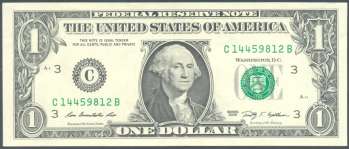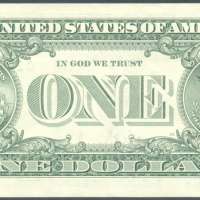BANK NOTE
USA $1 Series 2009
GENERAL INFORMATION
Country
United States of America
Denomination
1 US Dollar
Issued Date/Year
2009 CE - Common Era
Note Type
Paper - Circulation
Front Description
Federal Reserve Note | One Dollars | The United States of America | This note is legal tender for all debts, public and private
Back Description
In God We Trust
Note Printer
Federal Reserve Bank (Pennsylvania)
Dimension
156 × 66 mm
IN COLLECTION CONDITION
Preliminary
Normal
Condition
Uncirculated
USA $1 Series 2009
USA $1 Series 2009
The United States one-dollar bill ($1) is a denomination of United States currency. The first U.S. President (1789–97), George Washington, painted by Gilbert Stuart, is currently featured on the obverse, while the Great Seal of the United States is featured on the reverse. The one-dollar bill has the oldest reverse design of all U.S. currency, while the two-dollar bill has the oldest obverse design currently being produced. The obverse design seen today on the one-dollar bill debuted in 1963 when it first became a Federal Reserve Note.
The inclusion of the motto, "In God We Trust," on all currency was required by law in 1955, and first appeared on paper money in 1957.
An individual dollar bill is also less formally known as a one, a single, a buck, a bone, and a bill.
The Federal Reserve says the average life of a $1 bill in circulation is 4.8 years before it is replaced because of wear. Approximately 42 percent of all U.S. currency produced in 2009 were one-dollar bills.
Signatures
Rosa Gumataotao Rios
Treasurer, 6 August 2009 - ?
Timothy Franz Geithner
Secretary, 26 January 2009 - 25 January 2013
Obverse (Text From Top)
1
ONE DOLLAR
FEDERAL RESERVE NOTE
THIS NOTE IS LEGAL TENDER FOR ALL DEBTS, PUBLIC AND PRIVATE
A 2
3
FEDERAL RESERVE PENNSYLVANIA
BANK OF PHILADELPHIA
WASHINGTON, D.C.
A 61
(signature)
TREASURER OF THE UNITED STATES
SERIES 2009
(signature)
SECRETARY OF THE TREASURY
WASHINGTON
THE UNITED STATES OF AMERICA
ONE DOLLAR
Reverse (Text From Top)
1
ONE
THE UNITED STATES OF AMERICA
ANNUIT CŒPTIS
NOVUS ORDO SECLORUM
THE GREAT SEAL
IN GOD WE TRUST
ONE
E PLURIBUS UNUM
OF THE UNITES STATES
ONE DOLLAR
Latin Meaning
Taken from the Latin words annuo (third-person singular present or perfect annuit), "to nod" or "to approve", and coeptum (plural coepta), "commencement, undertaking", it is literally translated, "He approves (has approved) of the undertakings".
The phrase Novus ordo seclorum (Latin for "New Order of the Ages") appears on the reverse of the Great Seal of the United States, first designed in 1782 and printed on the back of the United States one-dollar bill since 1935. The phrase also appears on the coat of arms of the Yale School of Management, Yale University's business school. The phrase is also mistranslated as "New World Order" by many people who believe in a conspiracy behind the design; however, it does directly translate to "New Order of the Ages".
E pluribus unum is Latin for "Out of many, one" (alternatively translated as "One out of many" or "One from many") — is a phrase on the Seal of the United States, along with Annuit cœptis and Novus ordo seclorum, and adopted by an Act of Congress in 1782. Never codified by law, E pluribus unum was considered a de facto motto of the United States[citation needed] until 1956 when the United States Congress passed an act (H. J. Resolution 396), adopting "In God We Trust" as the official motto.
The United States one-dollar bill ($1) is a denomination of United States currency. The first U.S. President (1789–97), George Washington, painted by Gilbert Stuart, is currently featured on the obverse, while the Great Seal of the United States is featured on the reverse. The one-dollar bill has the oldest reverse design of all U.S. currency, while the two-dollar bill has the oldest obverse design currently being produced. The obverse design seen today on the one-dollar bill debuted in 1963 when it first became a Federal Reserve Note.
The inclusion of the motto, "In God We Trust," on all currency was required by law in 1955, and first appeared on paper money in 1957.
An individual dollar bill is also less formally known as a one, a single, a buck, a bone, and a bill.
The Federal Reserve says the average life of a $1 bill in circulation is 4.8 years before it is replaced because of wear. Approximately 42 percent of all U.S. currency produced in 2009 were one-dollar bills.
Signatures
Rosa Gumataotao Rios
Treasurer, 6 August 2009 - ?
Timothy Franz Geithner
Secretary, 26 January 2009 - 25 January 2013
Obverse (Text From Top)
1
ONE DOLLAR
FEDERAL RESERVE NOTE
THIS NOTE IS LEGAL TENDER FOR ALL DEBTS, PUBLIC AND PRIVATE
A 2
3
FEDERAL RESERVE PENNSYLVANIA
BANK OF PHILADELPHIA
WASHINGTON, D.C.
A 61
(signature)
TREASURER OF THE UNITED STATES
SERIES 2009
(signature)
SECRETARY OF THE TREASURY
WASHINGTON
THE UNITED STATES OF AMERICA
ONE DOLLAR
Reverse (Text From Top)
1
ONE
THE UNITED STATES OF AMERICA
ANNUIT CŒPTIS
NOVUS ORDO SECLORUM
THE GREAT SEAL
IN GOD WE TRUST
ONE
E PLURIBUS UNUM
OF THE UNITES STATES
ONE DOLLAR
Latin Meaning
Taken from the Latin words annuo (third-person singular present or perfect annuit), "to nod" or "to approve", and coeptum (plural coepta), "commencement, undertaking", it is literally translated, "He approves (has approved) of the undertakings".
The phrase Novus ordo seclorum (Latin for "New Order of the Ages") appears on the reverse of the Great Seal of the United States, first designed in 1782 and printed on the back of the United States one-dollar bill since 1935. The phrase also appears on the coat of arms of the Yale School of Management, Yale University's business school. The phrase is also mistranslated as "New World Order" by many people who believe in a conspiracy behind the design; however, it does directly translate to "New Order of the Ages".
E pluribus unum is Latin for "Out of many, one" (alternatively translated as "One out of many" or "One from many") — is a phrase on the Seal of the United States, along with Annuit cœptis and Novus ordo seclorum, and adopted by an Act of Congress in 1782. Never codified by law, E pluribus unum was considered a de facto motto of the United States[citation needed] until 1956 when the United States Congress passed an act (H. J. Resolution 396), adopting "In God We Trust" as the official motto.
COMMENTS
NEW COMMENT
|
The following text must accompany any text or photo taken from this page and limited use for non-commercial purposes only.
Texts and Images were taken from and courtesy of Exonumi.com
URL: http://www.exonumi.com/publish-BN.1.80
|
|

